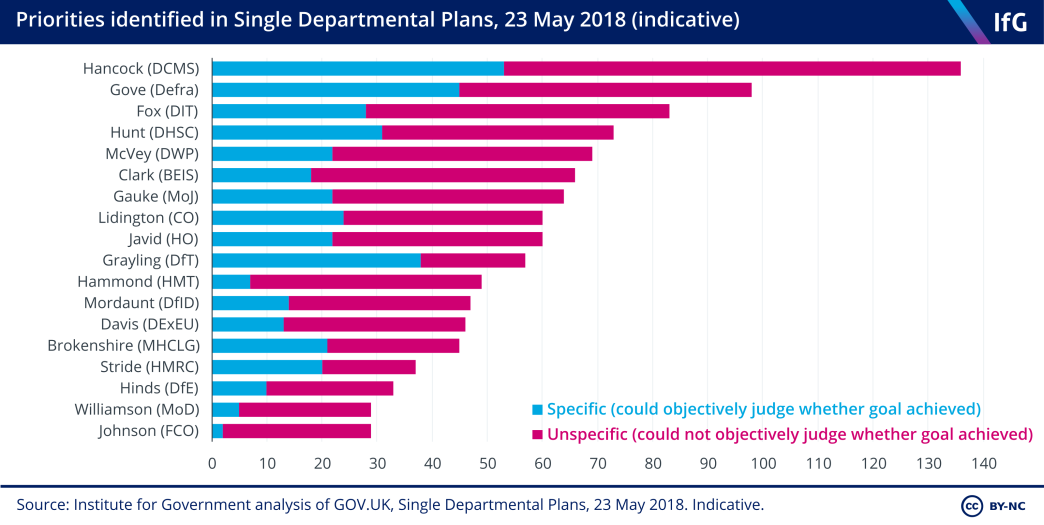Too many priorities mean no priorities
Ministers need to be clear about their priorities so that the next set of Single Departmental Plans are not just shopping lists of nice-to-haves.
The latest Single Departmental Plans still don’t link the Government’s priorities and the resources needed to deliver them, writes Gavin Freeguard.
Single Departmental Plans (SDPs), first proposed in summer 2015, were designed to be short, actionable lists of government priorities. With the civil service ‘doing too much’ given its resources, the SDPs would clarify government’s priorities, bring together inputs (resources available) with outputs (what government wanted to do), ‘making clear the trade-offs and choices’ and forcing the Government to make choices.
One referendum, one general election and nearly three years on, the latest SDPs – published on 23 May – are still not living up to these promises, bringing into question their usefulness for government in getting things done and for those of us on the outside holding it to account. (And, as Lewis Lloyd writes, they have also missed an opportunity to reassure us that Whitehall has Brexit covered.)
The SDPs still don’t link the spending and staff needed to deliver departments’ priorities

In our analysis (see the box below for methodology), we found that departments have a total of 1,081 ‘priorities’, just over a third of which are specific. There are more priorities than in the December 2017 plans, which had a total of 842. This was already too many, so the increase since is worrying. Ministers need to get a grip of their priorities and focus on what they want their departments to do.
The published plans still lack any link between departmental priorities and the spending, staff and skills required to deliver them, as originally promised; this is crucial for understanding trade-offs and forcing government to prioritise based on the resources it has available. There may be more of this detail in departments’ internal plans – the versions we see are the tip of the iceberg – but making more of this public would be good for accountability.
Many priorities across government remain vague and unspecific
Many priorities still lack obvious measures. It would not be possible to judge if they’d been achieved. For example:
- How is Defra planning to work out whether it succeeds in its intended action to ‘Build a culture which supports change and continuous improvement, including through the development of a compelling strategic vision and narrative for change’?
- What is the Foreign Office doing to ‘Raise the costs of malicious cyber activity and defend a free, open, peaceful and secure cyberspace’, and how is it measuring whether it is providing ‘high quality, accessible consular services globally, focused on those most in need’?
- In working to ‘Make the vision of a place you call home a reality’, how does MHCLG plan to ‘Reform the private rented sector so it is fairer and more affordable’, or the home-buying process ‘more efficient and less costly’?
There are some signs of improvement, including more performance measures
Some of the improvements evident in the December 2017 plans remain, such as a more consistent format and some top-level whole-of-government objectives.
And there has been some further progress which brings the plans closer to the original 2015 vision. For example:
- There are more indicators to help measure whether goals have been achieved: 12 out of 18 departments have more now than in December.
- Each plan includes a list of equalities objectives and links to the UN Sustainable Development Goals (which the UK signed up to in 2015).
- The plans now highlight which cross-cutting government priorities departments contribute to, such as housing, industrial strategy and homelessness and rough sleeping. Most link directly to political machinery, like Cabinet committees and implementation taskforces.
- There are signs that where political leadership has changed, so too have priorities, such as DfE.
But if SDPs are to be truly useful, for politicians driving their priorities and for the public in holding government to account, ministers need to be clear about their priorities so that the next set of SDPs are not just shopping lists of nice-to-haves. Crucially, the next set of SDPs must show stronger links with performance measures and indicators and make clear links between priorities and the spending, staff and skills needed to deliver them.
Additional analysis by Aron Cheung and James Taylor.
Abbreviations for government departments
The SDPs include objectives, sub-objectives and actions. In our indicative analysis of ‘priorities’, we looked at the highest level – objectives – and marked whether they were ‘specific’ – could somebody objectively judge if they had been achieved or not? If they weren’t, we moved down to sub-objectives, to judge if they were specific. If none of those were specific, we moved on to the actions.
- Supporting document
- 5890 IFG - Whitehall Monitor 2018 web.pdf (PDF, 5.4 MB)
- Topic
- Civil service
- Keywords
- Civil service reform Public spending
- Publisher
- Institute for Government